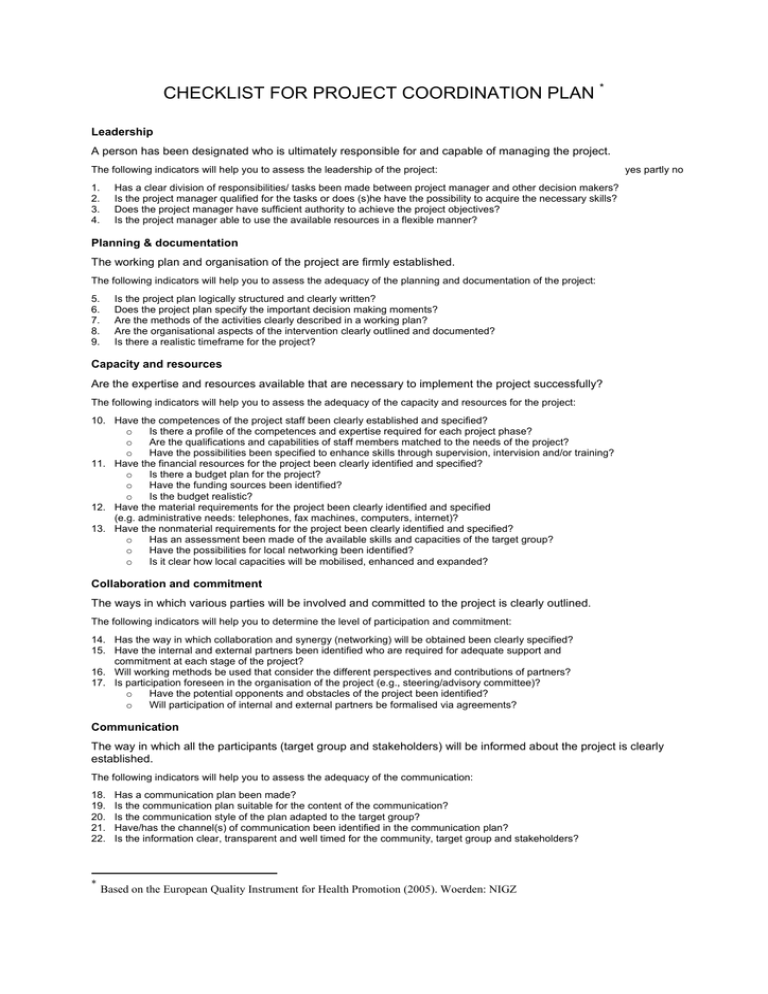CHECKLIST FOR PROJECT COORDINATION PLAN *
advertisement

CHECKLIST FOR PROJECT COORDINATION PLAN * Leadership A person has been designated who is ultimately responsible for and capable of managing the project. The following indicators will help you to assess the leadership of the project: 1. 2. 3. 4. yes partly no Has a clear division of responsibilities/ tasks been made between project manager and other decision makers? Is the project manager qualified for the tasks or does (s)he have the possibility to acquire the necessary skills? Does the project manager have sufficient authority to achieve the project objectives? Is the project manager able to use the available resources in a flexible manner? Planning & documentation The working plan and organisation of the project are firmly established. The following indicators will help you to assess the adequacy of the planning and documentation of the project: 5. 6. 7. 8. 9. Is the project plan logically structured and clearly written? Does the project plan specify the important decision making moments? Are the methods of the activities clearly described in a working plan? Are the organisational aspects of the intervention clearly outlined and documented? Is there a realistic timeframe for the project? Capacity and resources Are the expertise and resources available that are necessary to implement the project successfully? The following indicators will help you to assess the adequacy of the capacity and resources for the project: 10. Have the competences of the project staff been clearly established and specified? o Is there a profile of the competences and expertise required for each project phase? o Are the qualifications and capabilities of staff members matched to the needs of the project? o Have the possibilities been specified to enhance skills through supervision, intervision and/or training? 11. Have the financial resources for the project been clearly identified and specified? o Is there a budget plan for the project? o Have the funding sources been identified? o Is the budget realistic? 12. Have the material requirements for the project been clearly identified and specified (e.g. administrative needs: telephones, fax machines, computers, internet)? 13. Have the nonmaterial requirements for the project been clearly identified and specified? o Has an assessment been made of the available skills and capacities of the target group? o Have the possibilities for local networking been identified? o Is it clear how local capacities will be mobilised, enhanced and expanded? Collaboration and commitment The ways in which various parties will be involved and committed to the project is clearly outlined. The following indicators will help you to determine the level of participation and commitment: 14. Has the way in which collaboration and synergy (networking) will be obtained been clearly specified? 15. Have the internal and external partners been identified who are required for adequate support and commitment at each stage of the project? 16. Will working methods be used that consider the different perspectives and contributions of partners? 17. Is participation foreseen in the organisation of the project (e.g., steering/advisory committee)? o Have the potential opponents and obstacles of the project been identified? o Will participation of internal and external partners be formalised via agreements? Communication The way in which all the participants (target group and stakeholders) will be informed about the project is clearly established. The following indicators will help you to assess the adequacy of the communication: 18. 19. 20. 21. 22. * Has a communication plan been made? Is the communication plan suitable for the content of the communication? Is the communication style of the plan adapted to the target group? Have/has the channel(s) of communication been identified in the communication plan? Is the information clear, transparent and well timed for the community, target group and stakeholders? Based on the European Quality Instrument for Health Promotion (2005). Woerden: NIGZ
